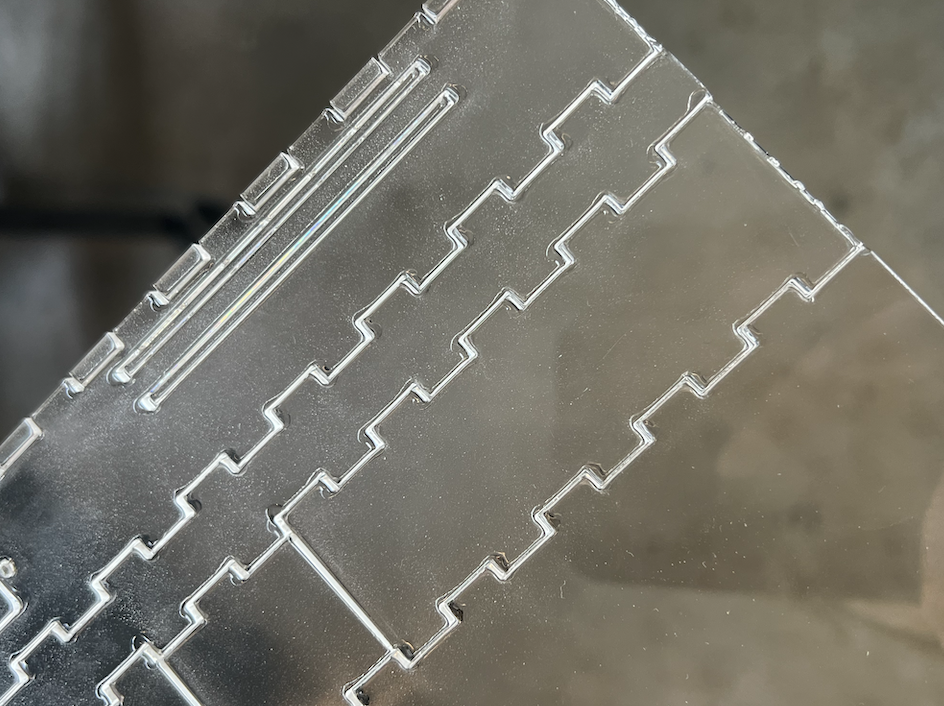Laser Safe Materials
Only approved materials can be used in the laser cutter. If you are unsure please visit the CCI technical office on the 5th floor of B block, Peckham Road, post in #technical on Slack.
Available in the Art Shop
The following materials form this list are in the Camberwell Art Shop in the D Block at Peckham Road:
- Cast Acrylic
- Plywood
- Polypropylene
- thin single walled cardboard e.g. 2mm cardboard
- paper
Approved materials
The following materials are approved for use in the laser cutter:
Be sure that the material is what you think it is before using it in the laser cutter.
Acrylic
Acrylic is probably one of the most commonly used materials in a laser cutter, there are two types:
Cast Acrylic
Cast acrylic, also known as PolyMethyl MethAcrylate (PMMA) is available in a vast number of colours and finishes under numerous brands including Perspex, Plexiglass and many others.
This material is a popular choice for laser cutting because it produces a smooth glass-like edge finish. When engraved it also produces a very clean effect, and can also be etched to produce a matt whitened finish.
Extruded Acrylic
Acrylic plastic is also available in an extruded version, the difference is how the product if fabricated. Cast acrylic is cast in a mould, where extruded acrylic is extruded through a form to create a sheet.
Extruded acrylic tends to be dimensionally more accurate than cast because of how it is produced. This means in specific engineering situations extruded acrylic might be preferable because it's thickness varies less across the sheet, however extruded acrlyic does not produce the same matt whitened finish when it's etched.
Cast acrylic is usually better for the type of work we undertake at UAL because the variation in thickness usually isn't substancial enough to cause problems. Laser-cutted Extruded acrylic would have blurry edges as shown below.

Plywood
Plywood is a commonly used material in laser cutting, however it has a very specific aesthetic, leaving a dark burned edge unless sanded. Additionally plywood is relatively absorbant and has no protective covering so it will stain with the vapourised fumes.
To prevent vapour staining you can cover the surfaces with masking tape that can be removed after.
Laser cut woods of all types can smell of burning for a long time after they've been processed in the laser cutter.
Paper and Cardboard
Paper and Cardboard are very quick to laser cut which makes them ideal for testing before cutting more expensive materials.
Paper
When laser cutting paper you must not cut more than 1 sheet at a time due to the risk of fire caused by heated gases being caught between the layers of paper.
Additionally you may need to reduce the air assist to prevent it from blowing smaller pieces of paper around.
Solid Cardboard
There are various types of solid cardboard such as grey board and thick paper stock.
Single wall corrugated cardboard
Only single wall corrugated cardboard should be used, the more layers the more risk of fire.
Corrugated cardboard can easily be cut but care should be taken as the flutes of the sheet can hold the hot gases and cause fire.
Materials with Limitations
The following materials can be used, subject to limitations detailed:
Ask a technician before using these materials in the laser cutter.
Polypropylene sheet
Polypropylene (PP) sheets are available in a number of thin sheets, it can be cut easily but the material it's not possible to etch into the surface as the plastic will only melt.
PP comes in a small number of colours including white and black, and usually has two different grains on the surface, one is fine the other more coarse. Because PP cuts at a relatively low power you will need to adjust the power levels for different colours that absorb more or less of the laser power.
Metal
Although metal can be cut by laser cutters, our laser cutter is not designed for this. Our laser cutter has an 80 watt CO2 laser tube which is fairly powerful, it's the wrong type of laser and its not powerful enough. A typical metal laser cutter would be a 12,000 watts fiber laser.
Our machine can however etch the surface of some metals such as annodised aluminium.
Glass, ceramic and stone
It is impossible to laser cut these materials, however they can be etched, but materials like glass can cause injury, please consult with a technician first.
Materials to Avoid
The following materials should be avoided:
Do not use these materials in the laser cutter.
MDF
MDF and Laser (Safe) MDF are not permitted to be used in the laser cutter as they leave a lot of residue inside the machine, block the filters and smell after being cut.
Forbidden Materials
These materials must not be used under any circumstances:
Never use these materials in the laser cutter.
PVC
Under no circumstances can PVC be cut, it produces toxic and corrosive gas which will cause serious damage to the laser cutter, potentially destroying it and the cases are very harmful to life.
Polycarbonate
PolyCarbonate (PC) is often confused with clear acrylic as they're visibly indistinguishable from one another, however PC does not behave the same when laser cut, the edges yellow and become brittle and/or cracked and produces a lot of flames when cutting.
Faux leather, pleather
These materials contain PVC, see above.
